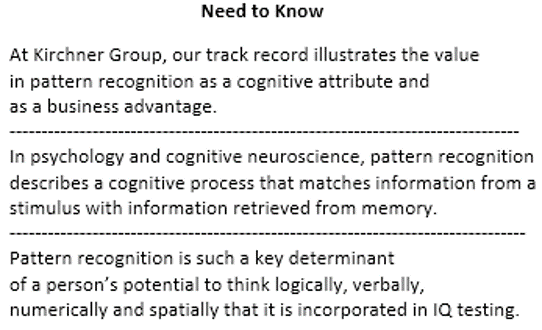Pattern Recognition and its Role in Decision Making
“Discovery consists of seeing what everybody has seen and thinking what nobody else has thought.”
February 18, 2020 ~ Written by: W.B. “Bud” Kirchner
Approx. Read Time: 15 Minutes
Context
“A man who carries a cat by the tail learns something he can learn in no other way.” – Mark Twain
We would like to propose a slightly different version of this little-known headline quote (credited to Albert Szent-Gyorgyi, who incorporated the concept in his Nobel acceptance speech). Our version would be: “Great business consists of seeing what others have seen, but thinking what nobody else has thought”.
The topic chosen has been the subject of volumes of research and even popular press books. As usual, we have tried to put it in the context of our personal experiences – thus validating any perspective and ultimately citing resources that we recommend.
We will start by reviewing our objective with these articles – creating a bridge between what psychology/neuroscience knows and what business does – we reiterate that this is not an academic exercise. It is an effort to enhance business and per our model (belief), create value in the world around us.
At Kirchner Group, we have enjoyed many successes as both advisors and principals over the years. When asked, we most often say a very large part of this is due to the fact that we (by design for four decades) have built a senior (greater than 25 years of individual experience) team and as a result, our ‘pattern recognition’ skills provide a major competitive advantage.
- We see opportunities and ‘landmines’ that others don’t
- We are quicker to come to a practical solution
- We expect dynamically evolving situations and people
- We use these talents to source problems and build strategies
Despite the fact that we often work in extreme conditions such as those related to rehabilitating companies and commercializing intellectual property, our track record illustrates the value in pattern recognition as a cognitive attribute and as a business advantage.
Mark P. Mattson (#8) considers superior pattern processing (SPP) as the fundamental basis of most, if not all, unique features of the human brain including intelligence, language, imagination, and invention. He further confirms that specific patterns, real or imagined, are reinforced by emotional experiences, which touches on a theme we have written on previously: How Embodied Is Your Cognition.
In The 21 Irrefutable Laws of Leadership, author John C. Maxwell writes that “leadership is really more art than science.” He also maintains that successful leaders have a “natural ability” to read situations and make the right decisions.” (#10)
In fact, pattern recognition is such a key determinant of a person’s potential to think logically, verbally, numerically and spatially that it is incorporated in IQ testing.
As a jumping off point, we can use the words of Will Joel Friedman, Ph.D. (#4):
“Applied pattern recognition draws upon a more holistic, intuitive or gestalt awareness in accurate and effective usage? If so, then the ability to troubleshoot, problem-solve and spot issues and resolve them very well, broadly conceived as pattern recognition, is a key ability or capability to cultivate in doing anything well.”
Our game plan in this article is to build out the idea of pattern recognition and to show its link to works previously cited in areas such as “intuition” and “thinking systems”.
Finally, we are intentionally not including herein topics such as machine learning and artificial intelligence. While the value of tools such as this is undeniable, we are always focused on the hardware/software that resides between the ears.
Definitions
“The best vision is insight.” – Malcolm Forbes
As always, one needs to ‘speak the language’ to navigate these topics and as is often the case why Wikipedia provides the convenient, yet appropriate level of detail:
In psychology and cognitive neuroscience, pattern recognition describes a cognitive process that matches information from a stimulus with information retrieved from memory.
Pattern recognition occurs when information from the environment is received and entered into short-term memory, causing automatic activation of specific content of long-term memory. An early example of this is learning the alphabet in order. When a career repeats ‘A, B, C’ multiple times to a child, utilizing the pattern recognition, the child says ‘C’ after he/she hears ‘A, B’ in order. Recognizing patterns allow us to predict and expect what is coming. The process of pattern recognition involves matching the information received with the information already stored in the brain. Making the connection between memories and information perceived is a step of pattern recognition called identification. Pattern recognition requires repetition of experience. Semantic memory, which is used implicitly and subconsciously is the main type of memory involved with recognition.
Steven Forth (#3) identified different forms of pattern recognition including:
- Spatial
- Temporal
- Auditory
- Linguistics
- Social interaction
- Numbers
He further identifies the essential components that enable pattern recognition:
- Similarity
- Transformation
- Connection
- Difference
Related terms
“There is nothing so terrible as activity without insight.” – Johann Wolfgang von Goethe
Heuristics are most easily thought of as “rules of thumb”. For example, memorizing the Fibonacci sequence would require a lot of rote repetition – 0,1,1,2,3,5,8,13,21,34,55,89,144,233. Remembering an easy rule (sum of previous two numbers) requires far less memory, and less memory retrieval time than storing the number sequence itself. (#6)
Gary Klein (#7) whom we will spend time with later cites an important differentiation in terms:
- Intuition is the use of patterns they’ve already learned
- Insight is the discovery of new patterns
Pitfalls
Finally, a devotee of pattern recognition needs to be aware of some of the pitfalls:
- Apophenia is the spontaneous perception of connections and meaningfulness of unrelated phenomena.
- Pareidolia is a type of illusion or misperception involving a vague or obscure stimulus being perceived as real and meaningful.
Taking it to the next level
“If I had asked people what they wanted,” he said, “they would have said a faster horse.” – Henry Ford
There are two authors that have taken this topic of pattern recognition and its role in decision making to still another (useful) level. The following condenses volumes of work to a couple salient points:
- Gary Klein, (the bibliography captures a list of articles we have written previously on Klein) who has used pattern recognition as a pillar in his multifaceted insight model via what he calls “recognition primed decision”:
- What is salient in this model is that while both intuition as well as rational methodology is used – the former is the deciding factor.
- The use of intuition enables us to:
- Decipher incomplete information
- Translate observations and experiences into opinions and initiatives
- Make decisions quickly
According to Wikipedia: Recognition-primed decision (RPD) is a model of how people make quick, effective decisions when faced with complex situations. In this model, the decision maker is assumed to generate a possible course of action, compare it to the constraints imposed by the situation, and select the first course of action that is not rejected. RPD has been described in diverse groups, including trauma nurses, fireground commanders, chess players, and stock market traders. It functions well in conditions of time pressure, and in which information is partial and goals poorly defined. The limitations of RPD include the need for extensive experience among decision-makers (in order to correctly recognize the salient features of a problem and model solutions) and the problem of the failure of recognition and modeling in unusual or misidentified circumstances. (#11)
Klein also encourages the use of pre-mortems as an additional tool – a topic that we have previously addressed in When is the best time to decide why you failed?
- Daniel Kahneman, (the bibliography captures a list of articles we have written previously on Kahneman) who has provided a qualifier based on his work wherein he describes two ‘systems’:
- “System 1 operates automatically and quickly, with little or no effort and no sense of voluntary control”
- “System 2 allocates attention to the effortful mental activities that demand it, including complex computations” (#5)
Patterns versus randomness wherein we conclude after observing similar random events, there is indeed a pattern. These and other insights reflect the work of Daniel Kahneman and Amos Tversy who founded the heuristics-and-biases movement, which catalogs and explains the different kinds of biases afflicting us.
Illustrations
Illustrations of the power of the RPD technique are everywhere. As Klein summarizes:
“Other researchers have replicated our findings and showed that different specialists, such as military commanders and oil-rig managers, also rely on what we called the recognition-primed decision strategy for about 90 percent of their challenging decisions. These efforts helped to start the field of naturalistic decision making.”
Finally (tongue in cheek), we provide a sports analogy. For those who know me, sports is not exactly a world in which I spend a lot of time, but even I understand the illustration here:
Apparently, there is a sport called hockey where several people skate at great speed to keep a “puck” away from each other and ultimately shoot it into a net. With all this happening at speeds as fast as someone can skate, the ‘strategy’ must be fast paced and precise. Apparently, one of the greats (I have confirmed this with Canadian friends and family) said: “I skate to where the puck is going to be, not where it has been.” – Wayne Gretzky (#2)
How do I get some of them?
“We are surrounded by data, but starved for insights.” – Jay Baer
On the back of our empirical results and Klein’s academic enhancement of the value and the additional perspective of Kahneman, any astute businessperson will want to learn to develop these skills – at least those that can be “learned”.
Using the same sequence as in the preceding text, we can start with straightforward activities that cultivate pattern recognition skills. According to Predictable Success (#9), here are some ideas:
- Study nature, art and math
- Study (good) architecture
- Study across disciplines
- Find a left-brain hobby
- Don’t read (much) in your own discipline
- Listen for echoes and watch for shadows
Klein’s techniques are as expected, different in nature since we would consider the above background skills while the following relates to implementation vis-à-vis creating insights. (#1):
- Contradictions – Nearly 40% of insights investigated by Klein involved spotting contradictions
- Connections – new connections were the source of 80%
- Creative Desperation – you gain insight into the hidden workings of a market under challenging conditions
- Look for coincidence and include these curiosities in a market
- Curiosities – observations that require investigation
- Coincidences – associations that are clearly ambiguous
While there is clearly a discipline that should be mastered around this process, we would propose there is no substitute for being there and doing it.
In Closing
The final word goes to the poet John Drinkwater as referenced by Klein:
Haunting the lucidities of life
That are my daily beauty, move a theme
Beating along my undiscovered mind.
Bibliography
- Brand Genetics – Seeing What Others Don’t [Speed Summary]
- Shawn Callahan – The problem with Wayne Gretzky’s puck advice
- Steven Forth – What skills improve pattern recognition?
- Will Joel Friedman, Ph.D. – Pattern Recognition: A Key to Success in Doing Anything Well
- GreenBook – Lessons from Thinking, Fast & Slow – System 1 and System 2
- Eric Haseltine Ph.D. – 7 Extraordinary Feats Your Brain Can Perform
- Gary Klein – Seeing What Others Don’t: The Remarkable Ways We Gain Insights
- Mark P. Mattson – Superior pattern processing is the essence of the evolved human brain
- Predictable Success – How To Develop Pattern Recognition Skills
- Robert Smither, Ph.D. – Leaders Should be Detectives, Not Psychics
- Wikipedia – Recognition primed decision
Business Brain Model articles re Klein:
- Creating Innovation: A Recipe for Innovation Stew
- A Neuroscience Perspective on Enhancing Innovation
- When is the best time to decide why you failed?
Business Brain Model articles re Intuition:
Business Brain Model articles re Kahneman:
- Human Nature as A Cause
- Freaking out about the guy the “Freakonomics” guy freaks out about
- Hooked on Hedonics: Is Happiness the next Holy Grail of Business?
- 10 Paradoxes that Will Bite You in the Ass (1st in Series)
- Daniel Kahneman Meets Dalai Lama
- What Can Paying Attention to Your Breath Do for You? Mindfulness Impact on Mind-Body-Soul
- TPN vs. DMN – Neural Mechanisms and Mindfulness
- Happy Birth Year, Henry David! Thank You for the Gift
- Our View of the World is Misleading – Part 1
- Our View of the World is Misleading – Part 2
- Augmented Cognitive Performance – Part 2 Tried and True
- Thaler Explained Why It Makes Sense That Things Don’t Make Sense
- It’s not stress that kills us; it is our reaction to it
- Thinking Errors: Part One – Is your Radar set to Detect Cognitive Traps?
- Thinking Errors: Part Two – The Ironic Magnitude of Cognitive Biases
- When is the best time to decide why you failed?
- A Neuroscience Perspective on Enhancing Innovation
Business Brain Model articles – other:
About the Author: W.B. “Bud” Kirchner is a serial entrepreneur and philanthropist with more than 50 years of business success. He is not a scientist or an academic but he does have a diversified exposure to neuroscience, psychology and related cognitive sciences. Generally speaking, the ideas he expresses here are business-angled expansions of other people’s ideas, so when possible, he will link to the original reference.




